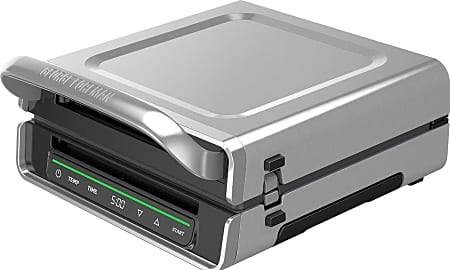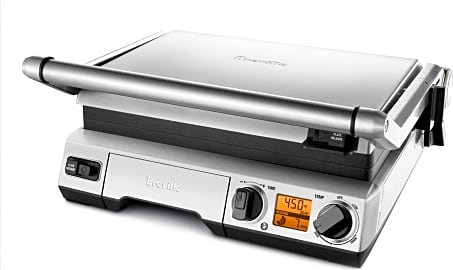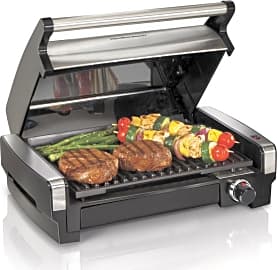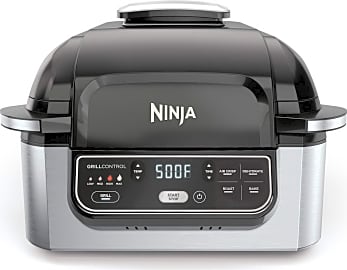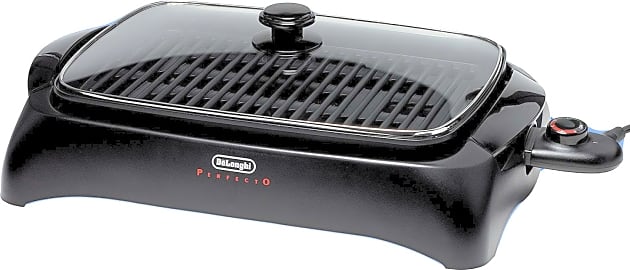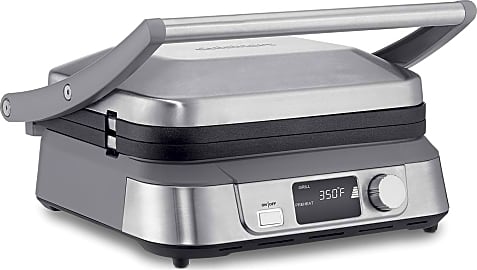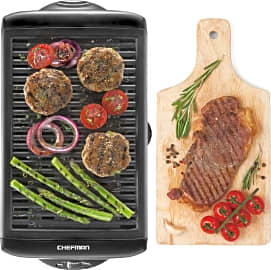The 10 Best Indoor Grills

This wiki has been updated 43 times since it was first published in March of 2015. Have a hankering for that home-cooked barbecue flavor, but the weather outside doesn't want to cooperate? Or perhaps you live in an apartment with no balcony. No problem. These electric indoor grills set up in seconds and will let you prepare anything from steaks and burgers to seafood and veggies in the comfort and warmth of your kitchen without having to wait for charcoal to heat up. When users buy our independently chosen editorial choices, we may earn commissions to help fund the Wiki.
Editor's Notes
December 16, 2020:
For this update we kept many of the same well-known, reliable kitchen brands but updated to their latest indoor grill model.
To provide more variety in our selections we removed the oldest Cuisinart model and replaced it with the Ninja Foodi. It's more powerful than some of our RV-friendly choices, (like the Hamilton Beach 25360), meaning less wait time and better searing results. But depending on how large your servings are, it may or may not accommodate four steaks as advertised.
Adding to our more family-friendly sized choices we added the George Foreman Family Size. While it's larger than the original George Forman, it's designed to be stored vertically so it takes up far less space when not in use, and the open grate bottom is a nice feature that's not common in a contact grill.
December 16, 2019:
During this update, we removed the Wolfgang Puck Electric because it was discontinued by the manufacturer and is no longer available in most physical and online stores. We also eliminated the Oster DuraCeramic Reversible due to many complaints of uneven heating and the nonstick coating wearing off very quickly. Additionally, we decided to get rid of the Livart Electric BBQ, not because there was anything wrong with it per se, but rather than we found that many consumers were buying it with different expectations of its capabilities and we didn't want any of our readers to experience that. It is intended solely for vegetables and small skewers of meat and will struggle with large cuts.
Often, grilling means giving up some of the precision of cooking in the oven or on a stovetop since it can be more difficult to control the heat. However, with the Breville BGR820XL, Cuisinart GR-300WS, and Cuisinart GR-5B, that problem will be a thing of the past. All of these feature a digital display that ensures you always know exactly how hot the grill plates are.
Along with the three previously mentioned models, we also like the Hamilton Beach 25360, Cuisinart GR-4N, and T-fal GC70 OptiGrill for their ability to function as panini presses, so if you like to make a lot of grilled sandwiches, any of these would be a good choice. The T-fal GC70 OptiGrill also deserves another mention for making preparing food a simple, and potentially error-free process. It has dedicated buttons for meats, poultry, sausages, and more, so it takes all the guesswork out of cooking times.
If you want something that resembles an outdoor grill, but offers the flexibility to be used indoors, the George Foreman GGR50B is a smart choice. It can be used on a tabletop or setup on the floor using the included stand, and it offers 240 square inches of cooking space.
Indoor Grilling And Health
When creating indoor grills, companies look to emulate this same process.
Using an indoor grill may actually lead to a healthier body. Many indoor grills are coated in a non-stick material, such as ceramic, silicone, or fluoropolymer, all of which function interchangeably: to keep food from sticking to the surface of the grill. If you're watching what's going into your body, a non-stick surface can translate into a less caloric intake, as non-stick materials require no additional fatty oils to prevent surface adhesion.
Additional reduction of calories comes from the adequate fat drainage on most indoor grills. When cooking in a pan, fat stays in the pan and on any food inside the pan. This is one of the benefits of grilling over sauteing or pan-frying. With a standard grill, excess fat simply drips off the food and into the fire. When creating indoor grills, companies look to emulate this same process. Many models offer drip pans or other ways for fats to wick away from the cooking surface.
The largest benefits to your health come from the long term use of an indoor grill. As indoor grills warm up quickly and require little clean up, customers are more likely to cook with them instead of using pans. This can cause long term reductions in dietary calories from saturated fats, which can aid in weight loss and keeping healthy cholesterol levels.
History Of Grilling
Grilling food over an open fire is the earliest known form of cooking. Though ancient grills were nowhere near as sophisticated as modern ones, the spirit of grilling remains the same. The word barbecue actually stems from a native Arawak word referring to a wooden structure used to roast meat over a fire. This structure is what is known today as the grill surface, while barbecue is typically used to refer to the entire grill or the event surrounding grilling, as in having a backyard barbecue.
After twelve to fourteen hours of cooking, the meat was ready.
The act of grilling known today stems from 18th-century colonial America. Carolina is said to be the place where American grilling began. A large pit was dug and lined with hot coals. Once the coals were up to temperature, an entire pig was hoisted into the pit to be roasted. After twelve to fourteen hours of cooking, the meat was ready.
This system of grilling has evolved and branched across the country into various distinct styles. Carolina style grilling still favors either a mustard or vinegar based sauce over their grilled goods. The Memphis grilling style incorporates either a distinct sticky-sweet tomato based sauce or a dry rub. Barbecues from Texas heavily favor beef and a mesquite-smoked, dry flavor on their grill. The Kansas City barbecue style is well rounded, involving customs from every grilling style. Most other areas in the country have adopted the Kansas City style of grilling with various meats and vegetables, all grilled under the common tomato based barbecue sauce found in stores.
Indoor Grills Trump Standard Grills
Using an indoor grill is actually a better choice than cooking over a standard charcoal or gas powered grill for many reasons. They can help the home chef save significant amounts of money. With standard charcoal grills, bags of briquettes, matches, and lighter fluid have to be purchased every time the grill will be used. Bulky and expensive propane bottles have to be purchased for gas powered grills to make them usable. An indoor grill simply requires an outlet and a flat surface, both of which can be found in any home.
When a charcoal grill is lit, it can take up to 30 minutes to get the coals up to temperature.
The use of an indoor grill also saves a significant amount of time. When a charcoal grill is lit, it can take up to 30 minutes to get the coals up to temperature. Even when these coals are set, the temperature can be inconsistent across the grill. This can cause a longer cooking time or food that is burnt on the outside, yet uncooked on the inside. Gas grills are slightly better; lighting simply takes the spark of a starter. But the size of most standard grills means there is still a long wait time required to bring the entire grill area up to the proper temperature. Indoor grills are the clear winners here. With the flip of a switch, efficient electrical currents evenly power the entire grilling area with little downtime required for heating. More time can be spent grilling instead of waiting for the grill to be ready.
Cleanup time is also much easier with an indoor grill. Maintaining a clean charcoal or gas grill means utilizing a heavy metal bristle brush to clumsily scrape all of the stuck on sauce and burnt oil that has accumulated on the griddle. Not only are there health risks associated with the use of these brushes, but the process can take longer than actually cooking the meal.
Additionally, once the coals have all turned to ash in the bottom of a charcoal grill, they have to be raked out and disposed of. Because of the non-stick surfaces and small sizes of indoor grills, cleanup is very easy. Wiping the cooled grill surface with a wet towel can be enough to clean most remaining food particles. For particularly heavy messes, there is no hard manual labor involved. Simply clean the grill surface in the sink as you would an everyday pan.


